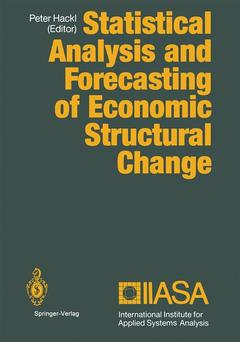Description
Statistical Analysis and Forecasting of Economic Structural Change, Softcover reprint of the original 1st ed. 1989
Coordinator: Hackl Peter
Language: English
Subjects for Statistical Analysis and Forecasting of Economic...:
Publication date: 12-2012
490 p. · 17x24.2 cm · Paperback
490 p. · 17x24.2 cm · Paperback
Description
/li>Contents
/li>
In 1984, the University of Bonn (FRG) and the International Institute for Applied System Analysis (IIASA) in Laxenburg (Austria), created a joint research group to analyze the relationship between economic growth and structural change. The research team was to examine the commodity composition as well as the size and direction of commodity and credit flows among countries and regions. Krelle (1988) reports on the results of this "Bonn-IIASA" research project. At the same time, an informal IIASA Working Group was initiated to deal with prob lems of the statistical analysis of economic data in the context of structural change: What tools do we have to identify nonconstancy of model parameters? What type of models are particularly applicable to nonconstant structure? How is forecasting affected by the presence of nonconstant structure? What problems should be anticipated in applying these tools and models? Some 50 experts, mainly statisticians or econometricians from about 15 countries, came together in Lodz, Poland (May 1985); Berlin, GDR (June 1986); and Sulejov, Poland (September 1986) to present and discuss their findings. This volume contains a selected set of those conference contributions as well as several specially invited chapters.
I Introduction.- 1 What Can Statistics Contribute to the Analysis of Economic Structural Change?.- II Identification of Structural Change.- 2 Testing for Structural Change in Simultaneous Equation Models.- 3 Specification and Stability Tests versus Jackknifing: Some Illustrative Examples S.- 4 The Robustness of the Chow Test to Autocorrelation among Disturbances.- 5 Tests against Nonconstancy in Linear Models Based on Counting Statistics.- 6 Nonparametric Tests for Shift and Change in Regression at an Unknown Time Point.- 7 Detection of Join Point in Regression Models.- 8 On the Identification of Time for Structural Changes by MOSUM-SQ and CUSUM-SQ Procedures.- 9 The Local Power of the CUSUM-SQ Test against Heteroscedasticity.- 10 Bahadur Efficiency of Tests for a Shift in Location of Normal Populations.- 11 The Use of Graphical Displays in the Analysis of Structural Change.- III Model Building in the Presence of Structural Change.- 12 Adaptive Estimation and Structural Change in Regression and Time Series Models.- 13 An Adaptive Method of Regression Analysis.- 14 Changing and Random Coefficient Models. A Survey.- 15 Nonparametric Estimation of Time-Varying Parameters.- 16 Latent Variables in Regression Analysis.- 17 Structural Change and Time Series Analysis.- 18 Thresholds, Stability, Nonlinear Forecasting and Irregularly Sampled Data.- 19 Forecasting in Situations of Structural Change: A General Approach.- 20 Updating Parameters of Linear Change Point Models.- IV Data Analysis and Modeling.- 21 Change Point Problem Relating to the Poverty Structure.- 22 Statistical Identification of Nonlinear Dynamics in Macroeconomics Using Nonlinear Time Series Models.- 23 Econometrics of Technical Change: Techniques and Problems.- 24 Local Autoregression Models for Detection of Changes in Causality.- 25 Investment, Taxation, and Econometric Policy Evaluation: Some Evidence on the Lucas Critique.- Author Index.- List of Authors.
© 2024 LAVOISIER S.A.S.




